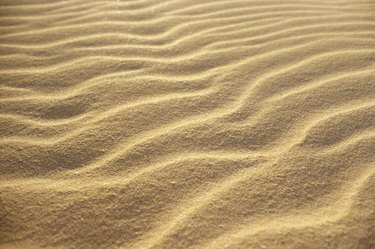Things You'll Need
Pencil
Drawing paper
Kneaded eraser
Photo reference (optional)

Sand is a common element in drawings of beach and desert landscapes. Drawing sand can present a dilemma to artists because it's impossible to draw each grain of sand, and communicating its texture seems like a daunting task. However, it is feasible to convey the look of sand through pencil marks with a few basic steps.
Step 1
Draw flat areas of sand using gentle shading. Sand often covers vast flat areas, such as on undisturbed beaches where there are virtually no structural forms. An inexperienced artist may see this and feel like there is nothing to draw, but subtle degrees of shadow can be seen in flat areas. Gently shade these areas with a blunted pencil point. Use subtle curves to make the surface look contoured. Experiment with shading in different shapes to convey more complex contours.
Video of the Day
Step 2
Draw sand dunes and mountains using precise lines and dramatic shadows. First, draw the lines indicating the sides and ridge of the dune. Indicate the arcs of the ridge with a curved or "S" shaped line. Then shade in one side of the ridge. Visualize the angle that the sun is hitting the dune to determine how far to extend the shadow. The taller the dune and the lower the sun is in the sky, the further the shadow will stretch. The highest point or arc of the ridge will have the longest shadow. Create shading, curves, contours and other variations in the dune and surrounding regions with a blunted pencil point.
Step 3
Draw rippling sands with shading and your eraser. Draw the shadowed trough of each ripple with a light line, or avoid lines and just use shading. Also experiment by uniformly shading the whole area and then drawing the crest of each ripple with a kneaded eraser. In this case you are drawing the light rather than the shadow.
Step 4
Combine techniques to create complex sand structures. In deserts, sand ripples often appear over larger dune structures. Draw the large dune sides and ridges, and then sketch ripples contouring over the curved sides of the dune. On sandy beaches traversed by many people, all sorts of random shapes evolve in the sand surface. Draw these by playing with various shapes of shadow and miniature ridges.
Tip
Look at pictures of deserts and beaches to see how sand forms shapes at different scales.
Consider the different color variations when drawing sand. Some "sand-scapes" may be an orange-red color, while others may be a faint yellow or even an off-white. Determine your color scheme first. Then use a range of colored pencils in your chosen color family to create lighter or dark areas.
Video of the Day